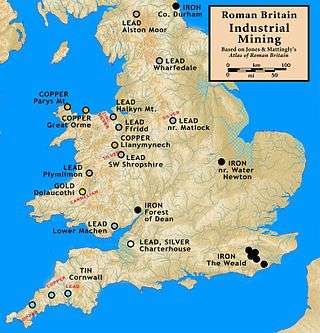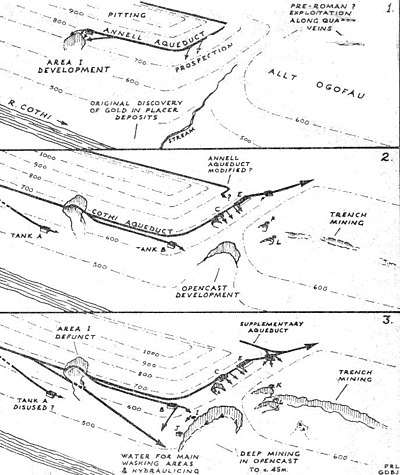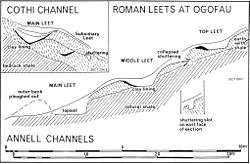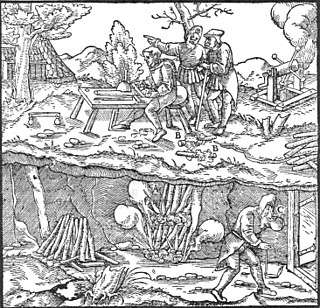Mining in Roman Britain
Mining was one of the most prosperous activities in Roman Britain. Britain was rich in resources such as copper, gold, iron, lead, salt, silver, and tin, materials in high demand in the Roman Empire. The Romans started panning and puddling for gold. The abundance of mineral resources in the British Isles was probably one of the reasons for the Roman conquest of Britain. They were able to use advanced technology to find, develop and extract valuable minerals on a scale unequaled until the Middle ages.

Lead mining

Lead was essential to the smooth running of the Roman Empire.[1] It was used for piping for aqueducts and plumbing, pewter, coffins, and gutters for villas, as well as a source of the silver that sometimes occurred in the same mineral deposits. Fifty-two sheets of Mendip lead still line the great bath at Bath which is a few miles from Charterhouse (see below).
The largest Roman lead mines were located in or near the Rio Tinto (river) in southern Hispania.[2][3] In Britannia the largest sources were at Mendip, South West England and especially at Charterhouse. In A.D. 49, six years after the invasion and conquest of Britain, the Romans had the lead mines of Mendip and those of Derbyshire, Shropshire, Yorkshire and Wales running at full shift. By A.D.70, Britain had surpassed Hispania as the leading lead-producing province. The Spanish soon lodged a complaint with the Emperor Vespasian, who in turn put limits on the amount of lead being produced in Britain. However British lead production continued to increase and ingots (or pigs) of lead have been found datable to the late second - early third century.[4] Research has found that British lead (i.e. Somerset lead) was used in Pompeii - the town destroyed in the eruption of Vesuvius in A.D.79.
Silver extraction
The most important use of lead was the extraction of silver. Lead and silver were often found together in the form of galena, an abundant lead ore. The Roman economy was based on silver, as the majority of higher value coins were minted from the precious metal.
The process of extraction, cupellation, was fairly simple. First, the ore was smelted until the lead, which contained the silver, separated from the rock. The lead was removed, and further heated up to 1100° Celsius using hand bellows. At this point, the silver separated from the lead, and was put into moulds which, when cooled, would form ingots that were to be sent all over the Roman Empire for minting.[1]
When inflation took hold in the third century A.D. and official coins began to be minted made of bronze with a silver wash, two counterfeit mints appeared in Somerset - one on the Polden Hills just south of the Mendips, and the other at Whitchurch, Bristol to the north. These mints, using Mendip silver, produced coins which were superior in silver content to those issued by the official Empire mints. Samples of these coins and of their moulds can be seen in the Museum of Somerset in Taunton Castle.
Gold mining


Britain's gold mines were located in Wales at Dolaucothi. The Romans discovered the Dolaucothi vein soon after their invasion, and they used hydraulic mining methods to prospect the hillsides before discovering rich veins of gold-bearing quartzite. The remains of several aqueducts and water tanks above the mine are still visible today. The tanks were used to hold water for hushing during prospecting for veins, and involved releasing a wave of water to scour the ground and remove overburden, and expose the bedrock. If a vein was found, then it would be attacked using fire-setting, a method which involved building a fire against the rock. When the hot rock was quenched with water, it could be broken up easily, and the barren debris swept away using another wave of water. The technique produced numerous opencasts which are still visible in the hills above Pumsaint or Luentinum today. A fort, settlement and bath-house were set up nearby in the Cothi Valley. The methods were probably used elsewhere for lead and tin mining, and indeed, were used widely before explosives made them redundant. Hydraulic mining is however, still used for the extraction of alluvial tin.
Long drainage adits were dug into one of the hills at Dolaucothi, after opencast mining methods were no longer effective. Once the ore was removed, it would be crushed by heavy hammers, probably automated by a water wheel until reduced to a fine dust. Then, the dust would be washed in a stream of water where the rocks and other debris would be removed, the gold dust and flakes collected, and smelted into ingots. The ingots would be sent all across the Roman world, where they would be minted or put into vaults.[1]
Iron mining
There were many iron mines in Roman Britain. The index to the Ordnance Survey Map of Roman Britain lists 33 iron mines: 67% of these are in the Weald and 15% in the Forest of Dean. Because iron ores were widespread and iron was relatively cheap, the location of iron mines was often determined by the availability of wood, which Britain had in abundance, to make charcoal smelting fuel. Great amounts of iron were needed for the Roman war machine, and Britain was the perfect place to fill that need.[5]
Many underground mines were constructed by the Romans. Once the raw ore was removed from the mine, it would be crushed, then washed. The less dense rock would wash away, leaving behind the iron oxide, which would then be smelted using the bloomery method. The iron was heated up to 1500 °C using charcoal. The remaining slag was removed and generally dumped.[5]
After being smelted, the iron was sent to forges, where it was reheated, and formed into weapons or other useful items.
Working conditions


Some miners may have been slaves, but skilled artisans were needed for building aqueducts and leats as well as the machinery needed to dewater mines and to crush and separate the ore from barren rock. Reverse overshot water-wheels were used to lift water, and sequences of such wheels have been found in the Spanish mines. A large section of a wheel from Rio Tinto can be seen in the British Museum, and a smaller fragment of a wheel found at Dolaucothi shows they used similar methods in Britain.
The working conditions were poor, especially when using fire-setting under ground, an ancient mining method used before explosives became common. It involved building a fire against a hard rock face, then quenching the hot rock with water, so that the thermal shock cracked the rock and allowed the minerals to be extracted. The method is described by Diodorus Siculus when he discussed the gold mines of Ancient Egypt in the first century BC, and at a much later date by Georg Agricola in his De Re Metallica of the 16th century. Every attempt was made to ventilate the deep mines, by driving many long adits for example, so as to ensure adequate air circulation. The same adits also served to drain the workings.
See also
- Derbyshire lead mining history
- Dolaucothi
- Metal mining in Wales
- Naturalis Historia
- Pliny the Elder
- Roman Britain
- Roman engineering
- Roman technology
- Roman metallurgy
Notes
- The Romans in Britain: mining Archived July 20, 2010, at the Wayback Machine
- http://cat.inist.fr/?aModele=afficheN&cpsidt=2099549 Lead from Carthaginian and Roman Spanish mines isotopically identified in Greenland ice dated from 600 B.C. to 300 A.D. ROSMAN K. J. R.; CHISHOLM W.; HONG S.; CANDELONE J.-P.; BOUTRON C. F.
- World Ecological Degradation, page 88. Sing C. Chew. Rowman Altamira, 2001. ISBN 0-7591-0031-4, ISBN 978-0-7591-0031-2 https://books.google.com/books?id=GM5WOHR55wYC
- Roman Britain: Industrial layer map Archived September 27, 2006, at the Wayback Machine
- Croydon Caving Club Archived November 27, 2006, at the Wayback Machine
References
- Davies, O, Roman Mines in Europe, Oxford (1935).
- Elkington H.D.H.The Mendip Lead Industry in Branigan K. and Fowler P.J. The Roman West Country (1976)
- Elkington H.D.H. The Development of the Mining of Lead in the Iberian Peninsula and Britain under the Roman Empire . Durham University Library (1968)
- Jones G. D. B., I. J. Blakey, and E. C. F. MacPherson, Dolaucothi: the Roman aqueduct, Bulletin of the Board of Celtic Studies 19 (1960): 71-84 and plates III-V.
- Lewis, P. R. and G. D. B. Jones, The Dolaucothi gold mines, I: the surface evidence, The Antiquaries Journal, 49, no. 2 (1969): 244-72.
- Lewis, P. R. and G. D. B. Jones, Roman gold-mining in north-west Spain, Journal of Roman Studies 60 (1970): 169-85.
- Jones, R. F. J. and Bird, D. G., Roman gold-mining in north-west Spain, II: Workings on the Rio Duerna, Journal of Roman Studies 62 (1972): 59-74.
- Lewis, P. R., The Ogofau Roman gold mines at Dolaucothi, The National Trust Year Book 1976-77 (1977).
- Annels, A and Burnham, BC, The Dolaucothi Gold Mines, University of Wales, Cardiff, 3rd Ed (1995).
- Burnham, Barry C. "Roman Mining at Dolaucothi: the Implications of the 1991-3 Excavations near the Carreg Pumsaint", Britannia 28 (1997), 325-336
- Hodge, A.T. (2001). Roman Aqueducts & Water Supply, 2nd ed. London: Duckworth.
- Burnham, BC and H, Dolaucothi-Pumsaint: Survey and Excavation at a Roman Gold-mining complex (1987-1999), Oxbow Books (2004).
Further reading
- Dark, K., and P. Dark. The landscape of Roman Britain. Stroud: Sutton, 1997.
- Jones, B., and D. Mattingly. An atlas of Roman Britain. Oxford: Oxbow, 2002.
- Reece, R. The coinage of Roman Britain. Stroud: Tempus, 2002.
- Schrüfer-Kolb, Irene. Roman Iron Production In Britain: Technological and Socio-Economic Landscape Development Along the Jurassic Ridge. Oxford: Archaeopress, 2004.
- Sim, D., and I. Ridge. Iron for the eagles: The iron industry of Roman Britain. Stroud: Tempus, 2002.
External links
| Library resources about Mining in Roman Britain |